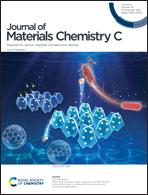High performance DUV-visible 4H-SiC-based multilayered SnS2 dual-mode photodetectors†
Abstract
Because of the in-gap defect levels, high deep ultraviolet (DUV) light absorption and low leakage current, the incorporation of a 4H-silicon carbide (SiC) substrate has been confirmed to enhance the optoelectrical properties of two-dimensional (2D) layered materials in recent years. Tin disulfide (SnS2) is a post-transition metal dichalcogenide (PTMD) with high light absorption coefficient and thickness-dependent band gap modulation, leading to potential applications in solar cells, DUV-visible photodetectors (PDs), and flexible wearable devices. Here, we first transferred SnS2 nanosheets onto a SiO2 layer and epitaxial n−-type 4H-SiC substrate, respectively. The optoelectrical performance of the SnS2/4H-SiC structure is improved under the UV and visible light. In particular, under 325 nm illumination, the photocurrent density significantly increased by ∼44 times, the response time is shortened to 17 ms, and the specific detectivity (D*) increases to 7.3 × 1013 Jones. Moreover, the responsivity (R325 nm) of 2.42 × 104 A W−1 is increased by one order of magnitude, which outperforms most of 2D materials DUV PDs reported up to date. In particular, the enhancement of mobility, decreased trap density, and suppression of dark current can be also obtained in the SnS2/SiC structure compared with the SnS2/SiO2 structure. This work provides a facile route toward 2D materials/SiC-based PDs with high performance, facile processing, and simple architecture for future applications in industrial, environmental, and even biological fields.



 Please wait while we load your content...
Please wait while we load your content...